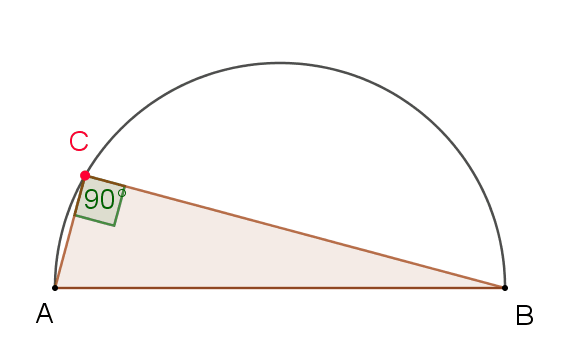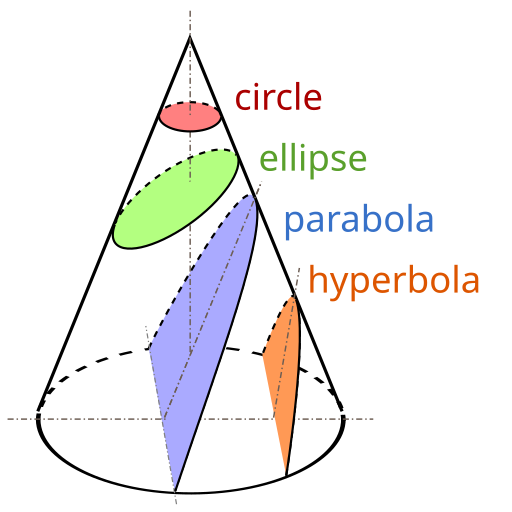Mathematics - All About Geometry (Part 4)
hive-163521·@drifter1·
0.000 HBDMathematics - All About Geometry (Part 4)
 [[Image1](https://pixabay.com/vectors/geometry-compasses-dividers-155184/)] ## Introduction Hey it's a me again [@drifter1](https://peakd.com/@drifter1)! This is the fourth part of my high-school refresher series on **Geometry**. I suggest checking out [part1](https://peakd.com/hive-196387/@drifter1/mathematics-all-about-geometry-part-1), [part2](https://peakd.com/hive-196387/@drifter1/mathematics-all-about-geometry-part-2) and [part3](https://peakd.com/hive-196387/@drifter1/mathematics-all-about-geometry-part-3) before this. So, without further ado, let's get straight into it! * * * ## Circle Theorems The properties of the circle lead to some interesting, mainly angle-related theorems. ### Inscribed Angles subtended by same Arc The angle that is made from points sitting on the circle's circumference is called an **Inscribed Angle**. Keeping the same end points and moving the middle (apex) point, doesn't affect the angle, if those points are within the remaining circumference of the circle. Consider the figure below. In this figure the apex points *A* and *B* form the angles *a* and *b*, which are equal because they are subtended by the same arc (the red one).  [[Image 2](https://commons.wikimedia.org/wiki/File:Subtended_-Arc_of_circle_subtended_by_two_angles.svg)] ### Angles at the Center and at the Circumference In addition to the previous theorem, the inscribed angle and the angle made from the center towards the end points are also related, in the following way: ``` The center angle is twice the inscribed angle if both have the same end points and are within the same arc. ``` For example, this applies for the ABC - AOC pair shown below:  Moving point B along the upper AC arc doesn't affect the angle, as well as the relation between the angles. ### Angle in a Semicircle (Thales' Theorem) A special case of the previous theorem is **Thales' Theorem**, which tells us that an inscribed angle across a circle's diameter is always a right angle. In other words, the inscribed angle formed by the endpoints of a circle's diameter is always the same, anywhere on the circumference, and always equal to *90°*, because the center angle will be *180°* (line) for both sides of the semicircle.  [[Image 3](https://commons.wikimedia.org/wiki/File:Thales_kreis_animation.gif)] ### Opposite Angles in a Cyclic Quadrilateral A **Cyclic Quadrilateral** is a quadrilateral with all it's vertices on a circle's circumference. The opposite angles in such a quadrilateral have the special property of always adding up to *180°*. For example, in the figure below, *α + γ = 180°*, and *β + δ = 180°*:  [[Image 4](https://commons.wikimedia.org/wiki/File:ABCD_-_cyclic_quadrilateral.png)] ### Lengths of Tangents from a Point to a Circle are Equal From a point outside a circle two tangent lines (or tangents) can be drawn. The distance from that point towards the points of contact is the same in both cases. For example, if *A* is a point outside a circle, and *B* and *C* are the points of contact of the two tangents, then the line segments *AB* and *AC* will have equal length, as shown below.  ### Angle between a Tangent and a Circle's Radius As a continuation of the previous theorem, what are the angles *ABO* and *ACO*, if *OB* and *OC* are both equal to the radius? Well, the **angle between a tangent and a radius of a circle is always exactly *90°***. In other words, a tangent line and the radius which can be drawn from the center towards the point of contact of the tangent line are perpendicular to each other. ### Alternate Segment Theorem The **Alternate Segment Theorem** states: ``` For any circle, the angle between a tangent and a chord through the point of contact of the tangent is equal to the angle made by the chord in the alternate segment. ``` Visually, it's easier to understand it. So, explain the figure below.  In this figure, the angles *ACE* and *CDE* are equal. The angles will also be equal if Point *E* is moved along the circumference, but stays in the segment opposite to the tangent. ### Perpendicular from Center Bisects Chord A line which passes through the center, and is perpendicular to a chord, bisects that coord (splits it into two equal parts), as shown below.  * * * ## Conic Sections Taking different slices through a cone, one can create circles, ellipses, parabolas and hyperbolas. All these shapes are thus related and called conic sections.  [[Image 5](https://commons.wikimedia.org/wiki/File:Conic_Sections.svg)] * **Circle** : created by cutting straight through a cone * **Ellipse** : created by cutting a cone in a slight angle * **Parabola** : created by cutting parallel to an edge of a cone * **Hyperbola** : created by cutting a cone in a steep angle ### Focus and Directrix Conic sections can be defined using a straight line and a point, which are called **directrix** and **focus**. In the special case of an ellipse there are two focus points, called **foci** and two directrix lines, one on each side. When measuring the distance from the focus to a point on the curve, and perpendicular from the directrix to that point, the two distances always have the same ratio: * For a circle the ratio is 0, because the directrix is a tangent of the circle, thus having a distance of 0 towards any point on the circumference of the circle * For an ellipse the ratio is less than 1 * For a parabola the ratio is exactly equal to 1 * For a hyperbola the ratio is greater than 1 The figure below shows the definition of a parabola.  [[Image 6](https://commons.wikimedia.org/wiki/File:Parts_of_Parabola.svg)] ### Eccentricity The ratio mentioned previously is a property called **Eccentricity**. For any conic section the points on the curve have a distance to the focus which is equal to the eccentricity times the distance to the directrix. Therefore: * **Circle** : eccentricity = 0 * **Ellipse** : 0 < eccentricity < 1 * **Parabola** : eccentricity = 1 * **Hyperbola** : eccentricity > 1 So, eccentricity basically shows us how "un-circular" a curve is. The higher the number the less the curvature. Of course, a straight line has an eccentricity of infinity. ### Vertex and Focal Length A line from the focus point towards the directrix, which is perpendicular to the directrix, cuts the curve at a specific point, which is called a **vertex**. The distance from the focus point to the vertex is the **focal length** of the conic section. ### Latus Rectum The **latus rectum** (latin for "side" and "straight") is a line parallel to the directrix which passes through the focus. Depending on the shape its length is: * Parabola : four times the focal length * Circle : equal to the circle's diameter (or twice the radius) * Ellipse : equal to *2b²/a*, where *a* and *b* are half the major (or transverse) and minor (or conjugate) diameter * Hyperbola : equal to *2b²/4a*, where *a* and *b* are half the diameter of the transverse and conjugate axis respectively. To understand this better, the axes of an ellipse, as well as the distances *a* and *b* are shown below. F<sub>1</sub> and F<sub>2</sub> are the foci of the eclipse, and *C* its center.  [[Image 7](https://commons.wikimedia.org/wiki/File:Ellipse_semi-major_and_minor_axes.svg)] ### Equations When placing these shapes on the Cartesian Coordinate System with the center at *O (0,0)*, the **equations** that define all but the parabola are as follows:  The circle is basically a "special" case of the ellipse where *a = b = r*. There also exists a **General Equation**, which covers all of these plane curves, which is:  Using only *x* and *y*, even with factors, will only yield straight lines. Thus, at least one square of them (*x²*, *y²*) or the combined *xy* needs to have a non-zero factor. A simple example of a parabola is the quadratic function *y = x²*, with the following plot:  [[Image 8](https://commons.wikimedia.org/wiki/File:Y%3Dx%5E2.png)] * * * ## RESOURCES: ### References 1. [https://www.khanacademy.org/math/geometry-home](https://www.khanacademy.org/math/geometry-home) 2. [https://www.mathsisfun.com/geometry/](https://www.mathsisfun.com/geometry/) 3. [https://www.splashlearn.com/math-vocabulary/topics/geometry--4](https://www.splashlearn.com/math-vocabulary/topics/geometry--4) 4. [http://www.timdevereux.co.uk/maths/geompages/8theorem.php](http://www.timdevereux.co.uk/maths/geompages/8theorem.php) 5. [https://www.cuemath.com/geometry/alternate-segment-theorem/](https://www.cuemath.com/geometry/alternate-segment-theorem/) 6. [https://www.vedantu.com/maths/latus-rectum](https://www.vedantu.com/maths/latus-rectum) ### Images 1. [https://pixabay.com/vectors/geometry-compasses-dividers-155184/](https://pixabay.com/vectors/geometry-compasses-dividers-155184/) 2. [https://commons.wikimedia.org/wiki/File:Subtended_-Arc_of_circle_subtended_by_two_angles.svg](https://commons.wikimedia.org/wiki/File:Subtended_-Arc_of_circle_subtended_by_two_angles.svg) 3. [https://commons.wikimedia.org/wiki/File:Thales_kreis_animation.gif](https://commons.wikimedia.org/wiki/File:Thales_kreis_animation.gif) 4. [https://commons.wikimedia.org/wiki/File:ABCD_-_cyclic_quadrilateral.png](https://commons.wikimedia.org/wiki/File:ABCD_-_cyclic_quadrilateral.png) 5. [https://commons.wikimedia.org/wiki/File:Conic_Sections.svg](https://commons.wikimedia.org/wiki/File:Conic_Sections.svg) 6. [https://commons.wikimedia.org/wiki/File:Parts_of_Parabola.svg](https://commons.wikimedia.org/wiki/File:Parts_of_Parabola.svg) 7. [https://commons.wikimedia.org/wiki/File:Ellipse_semi-major_and_minor_axes.svg](https://commons.wikimedia.org/wiki/File:Ellipse_semi-major_and_minor_axes.svg) 8. [https://commons.wikimedia.org/wiki/File:Y%3Dx%5E2.png](https://commons.wikimedia.org/wiki/File:Y%3Dx%5E2.png) Mathematical equations used in this article, have been generated using [quicklatex](http://quicklatex.com/). Block diagrams and other visualizations were made using [draw.io](https://app.diagrams.net/). * * * ## Final words | Next up And this is actually it for today's post! Next time we will get into Solid Geometry... Also, currently, other ideas for "All About" articles that I have in mind include: * Polynomial Arithmetic * Exponentials and Logarithms * Rational Expressions Basically more High-School Math Refreshers! See ya!  Keep on drifting!
👍 stemd, gangstalking, joeyarnoldvn, khalstem, slider2990, ctime, portugalcoin, warnas, acont, redes, investegg, sanguinehaze, drsensor, drifter2, yggdrasil.laguna, brofund-stem, meestemboom, adamada.stem, solominer.stake, solominer.stem, modeprator, smartvote, babytarazkp, rupinder, scholaris.stem, pimpstudio, harpreetjanda, vikenson777, limka, ocd, roelandp, rt395, dzoji, olumzy, devann, fiveboringgames, eonwarped, tugbabeauty, ocd-witness, haccolong, ocdb, javyeslava.photo, squareonefarms, zeesh, hive-180164, dpend.active, actioncats, leveluplifestyle, partiesjohall, dibblers.dabs, romeskie, hoaithu, pavanjr, kawsar8035, ordet, askari, redrica, hadji, variedades, markjason, jude.villarta, hiveph, hivephilippines, jonalyn2020, bloghound, bearone, appleskie, maverickinvictus, junebride, jazzhero, steemph.uae, bella.bear, mami.sheh7, detlev, fengchao, kneelyrac, mrnightmare89, gabrielatravels, gohenry, djean, beerlover, mammasitta, pradeepdee6, michellpiala, yiobri, arcange, raphaelle, laruche, walterjay, pboulet, cleanplanet, hive-143869, dkmathstats, steem-on-2020, satoshi-group, enforcer48, holovision.stem, brofi, upfundme, discohedge, bidnat, chapmain, tonimontana, aninsidejob, memehub, freebornsociety, memecurator, memesupport, tfranzini, krishu.stem, pfwaus, stemcur, trans-juanmi, abh12345.stem, cd-stem, dorkpower, juecoree.stem, zdigital222, mathworksheets, mproxima,